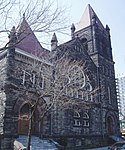First Narayever Congregation
First Narayever Congregation is a traditional-egalitarian synagogue located at 187 Brunswick Avenue, in the Harbord Village neighbourhood of Toronto, Ontario, Canada. It is the largest Jewish congregation in downtown Toronto. It was founded by the Jewish immigrants from Narayiv, western Ukraine, hence the Yiddish name "Narayever". Founded by 1914 as an Orthodox synagogue by Galician immigrants to Toronto, it was a landsmanshaft, an association whose members had immigrated from the same town, in this case the town of Naraiev. The congregation originally met in a rented building at the corner of Huron and Dundas. In 1943, the congregation acquired and moved to its current building on Brunswick which had previously been Bethel Church and originally a Foresters' Lodge.In the decades following World War II, many of the congregants followed the rest of the Jewish community as it moved up Bathurst Street north of St. Clair Avenue, but some continued to travel downtown to attend the synagogue. Other Jews who had remained in the neighbourhood began attending after their own synagogues moved north. Younger professionals and more liberal members joined the congregation in the 1970s and 1980s and, after the older generation retired from the synagogue's board in 1983, an alternative egalitarian service was introduced downstairs while the Orthodox service continued in the main sanctuary. As attendance for the Orthodox service dwindled to the point that it was unable to attract a minyan, the egalitarian service moved upstairs and the synagogue began attracting more new members and went in a new direction, and is today unaffiliated with any larger Jewish religious movement.Narayever today follows traditional halakha except in making no distinction on the basis of gender. The Birnbaum siddur (Nusach Sefard) forms the basis of the liturgy. In 2009, the congregation voted to endorse the celebration of same-sex marriages.Ed Elkin has been the congregation's rabbi since 2000.
Excerpt from the Wikipedia article First Narayever Congregation (License: CC BY-SA 3.0, Authors).First Narayever Congregation
Brunswick Avenue, Toronto
Geographical coordinates (GPS) Address Phone number Website External links Nearby Places Show on map
Geographical coordinates (GPS)
| Latitude | Longitude |
|---|---|
| N 43.66288 ° | E -79.4059 ° |
Address
First Narayever Congregation
Brunswick Avenue 187
M5S 2R5 Toronto
Ontario, Canada
Open on Google Maps









